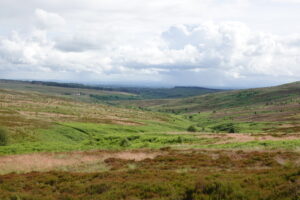Photograph: Mairi Telford Jammeh
Habitats
We protect the lands and the waters of the Nature Reserve habitats — the woodlands, wetlands, freshwater and meadows — creating an environment conducive to avian, terrestrial and aquatic wildlife.


Birch and Ancient Oak Woodland
One of the most popular walks on the reserve is through the Longwood woodland on the South-West of the reserve, and can be accessed from the town. This woodland has only existed since the 1960s, when the sheep that had previously grazed there were removed.
Birch is the most abundant species in the woodland, but dotted throughout are a large number of veteran oak trees. These impressive trees have stood in this area for over 400 years, increasing the woodland biodiversity by providing a habitat for a variety of different species, including woodland birds, such as Pied Flycatchers; bats and other mammals, and countless invertebrates. In order to protect these trees for future generations, we will be felling small numbers of birch trees, which will provide more light and space to the magnificent oak trees.

Moorland and blanket bog
Much of the reserve has historically been managed as a grouse moor, and evidence of the historical management practices, such as draining and burning, is visible across much of the moorland. Between Hog Fell and Whita Hill on the western side of the reserve, a patchwork of dwarf shrub heath, and peat bogs can be found, while blanket bog can be found in several other areas in the north and east of the reserve.
Dwarf shrub heath in this area is heavily dominated by ling heather and blaeberry. In late summer, the whole moorland is turned a beautiful purple by the flowering heather, and the ripe blaeberries provide a tasty snack for both wildlife and people!
While the bog habitats are widely dominated by tall grasses, take a closer look and you will find a range of different bog species, including cranberry, cowberry, and many different mosses.
The ‘Langholm Moor’ is a popular birdwatching location, with a variety of rare and threatened bird species. On the reserve, there are breeding populations of Hen Harriers, Short-eared Owls, Merlins, Curlew, Black Grouse, and a whole host of other species.

Wood Pasture, Wetlands and the River Tarras
Some of our most picturesque habitats follow along the River Tarras in the bottom of the valley. With ancient Alder trees, inhabited by ‘flying Rowans’ growing from cracks in their branches and trunks, as well as many other tree and ground flora species running along the river valley, this beautiful habitat is the perfect spot to watch for river wildlife, including otters, dippers and pied flycatchers.
There are many deeper pools along the river, which are home to larger fish such as salmon and trout, which use the Tarras as a spawning ground. Due to the lack of pollution and river management, the Tarras is an excellent example of a clean, natural river, and has an abundance of invertebrates which help to support the varied wildlife.
During summer, you may be lucky enough to see the field of Yellow Flag Irises in bloom. The area may look like a grass field, but be careful not to attempt to cross without wellies, as the hidden wetland contains many deeper pools which provide a breeding site for frogs, toads and newts.